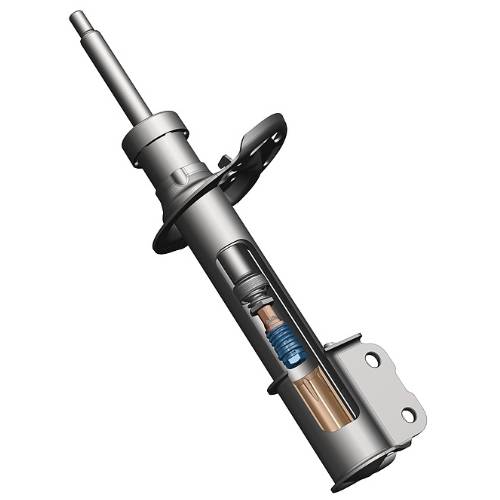 京西重工集团直接将高阻尼液压止动系统(HCS)整合在减振器内,替代传统设计中的硬止动模块。
京西重工集团直接将高阻尼液压止动系统(HCS)整合在减振器内,替代传统设计中的硬止动模块。 如图所示,在低阻尼系统中,京西重工采用了一根阻尼管开两大小口的设计。
如图所示,在低阻尼系统中,京西重工采用了一根阻尼管开两大小口的设计。 京西重工集团技术开发经理Roman Bielak表示,现在,摆在被动减振器面前的挑战是如何在保持价格优势的前提下,尽量缩小与自适应性悬架系统之间的性能差距。
京西重工集团技术开发经理Roman Bielak表示,现在,摆在被动减振器面前的挑战是如何在保持价格优势的前提下,尽量缩小与自适应性悬架系统之间的性能差距。 京西重工集团推出的精密磁流变悬架控制系统MagneRide(如图所示)。
京西重工集团推出的精密磁流变悬架控制系统MagneRide(如图所示)。
所有汽车厂商都希望在不明显增加成本的情况下让自己的产品更加脱颖而出。虽然直接利用软件来控制精密系统可以在一定程度上实现这个目标,但仅凭机械手段“改变”这些系统可能存在一定困难,特别是当人们对“改变”的主观意愿是“优化”的情况下。
驾乘性能的优化是一个明显的例子。中国底盘系统供应商京西重工(BWI Group)推出了一款精密的磁流变悬架控制系统MagneRide,这款产品的客户包括奥迪(Audi)、凯迪拉克(Cadillac)、雪佛兰(西尔维拉多皮卡和巡洋舰)及法拉利等多个高端品牌。但除此之外,京西重工还推出了一款更加平价的悬架控制系统,目标车型是旨在提升驾乘体验的中级轿车。
液压止动系统(Hydraulic Compression Stop)
为了在不牺牲操控和安全性能的前提下优化车辆的驾乘体验,京西重工计划将从常规的止动模块设计入手。具体来说,工程师计划用一款液压止动系统(HCS)取代硬止动模块的设计,从而优化传统被动减振器的性能。
“在高端市场中,MagneRide等自适应性悬架技术几乎可以协助车辆在驾乘舒适度和车身控制之间达到完美平衡。”京西重工集团技术开发经理Roman Bielak表示,“现在,摆在被动减振器面前的挑战是如何在保持价格优势的前提下,尽量缩小与自适应性悬架系统之间的性能差距。HCS系统的出现就是实现这一目标的重要一环。”
Bielak告诉《汽车工程》,这款HCS系统经过专门设计,旨在车轮的完整振幅范围内优化车辆的减震性能,尽量减少路面振动传入车内:“与传统的止动模块相比,新系统在改装调试方面的灵活度更高,可以优化车辆的动态性能,而且还能通过降低车轮在极限位置时的车身峰值受力,优化整车的NVH性能。”
据了解,京西重工的HCS系统按计划将于2018进入生产。该系统背后的设计理念是降低系统在极限压缩状态下的峰值负荷。这样一来,底盘设计师就可以更充分地利用减振器行程,改善车上人员的舒适度和底盘性能。此外,这还可有助于降低车身重量,而且不会对车辆的驾乘或操控性能产生影响。
Bielak表示,“如果有一辆满载的汽车行驶在颠簸道路上,那这辆车的悬挂系统极有可能达到下极限。此时,HCS系统就可以避免车辆将负载压力转移到车身结构上。”
京西重工HCS系统以集团的液压反弹止动技术(HRS)为基础,而后又进行了一系列改造,从而将系统的重点从反弹转为压缩。HRS和HCS系统均可以在悬挂处于极限位置时,将能量分散至液态阻尼液中,从而降低冲击对车身的影响。目前,京西重工正在向多家厂商演示HCS系统。
HCS系统目前有两种配置,分别适用于高/低阻尼要求下的应用。高阻尼系统增加了一个密封液压腔,腔体存在一条旁路通向减振器的液压阀。这个独立的腔室可以产生非常高的阻尼力,但并不会影响悬架行程其余部分的减振表现。
在需求较低的低阻尼系统中,京西重工集团采用了一条阻尼管开大小两口的设计。其中,较大的口充当主阻尼阀,较小的口可在达到指定阈值时开始工作,防止系统进入极限位置。
可应用于混动和电动车
Bielak解释说,这种设计可以给减振器的调试带来更大的灵活度,但他也解释说,系统的最大阻尼不能超过极限范围,这样才能保证基础减振器的性能不会受到充油的影响。
“为了满足不同车型的特定要求,我们开发了两款HCS系统。”Bielak指出,“这两种系统都可以优化车辆的舒适性和耐久性,但其中一款在微调方面的潜力较大,另一款则可以提供更大的阻尼。”
Bielak补充说,虽然HCS系统最初是针对中档轿车设计的,但由于该系统不需要对悬挂系统做大规模的改动,因此还可以用于现有车型的混动或电动版本。“该技术可以很好地应对电动车大型电池组带来的额外重量,”Bielak表示,“还可以将悬挂系统的噪声控制在较低水平,从而保证电动模式下的安静驾乘体验。”
目前,京西重工的潜在客户(并未透露客户信息)正在考察低阻尼版的HCS系统。集团已证实该系统将于2018年进入生产。
Achieving product differentiation without adding significant cost is on the wish list of all automakers. While targets can be reached to some degree by applying clever software changes to sophisticated systems, using purely mechanical solutions as an alternative to those systems may be difficult, particularly in that subjective area categorized as “refinement.”
Ride refinement is a prime example. China-based chassis systems’ supplier BWI Group produces the sophisticated magneto-rheological suspension control, MagneRide, used by a growing list of brands including Audi, Cadillac, Chevrolet(Silverado pickups and Corvettes) and Ferrari. But BWI is also developing what it believes will be a cost-effective system aimed at raising the ride quality of mid-class premium cars.
Enter the HCS
It is doing so by focusing its R&D on the conventional bump stop as a route to improving ride comfort without degrading vehicle handling and safety. BWI engineers plan to extend the performance of conventional passive dampers by replacing hard bump stops with an hydraulic compression stop (HCS) integrated into the damper.
“At the top end of the market, adaptive suspension technology such as MagneRide virtually eliminates the compromise between ride comfort and body control,” explains Roman Bielak, BWI Group’s Technology Development Manager. “The challenge with passive dampers is to retain the price advantage while closing the performance gap to adaptive systems. HCS is an important step towards this.”
It is designed to better optimize damping over the full amplitude of wheel travel to secure improved road isolation: “The new system is not only more tunable than traditional bump stops, leading to better vehicle dynamic performance, but improves NVH by reducing peak forces transmitted to the vehicle body at the limit of travel,” Bielak told Automotive Engineering.
Thinking behind the HCS, due to enter production in 2018, is to soften the load spikes that normally occur at the limit of compression. This would allow chassis designers to make greater use of the available damper travel to improve occupant comfort and chassis refinement. It would also complement and facilitate reduced weight of a vehicle’s body without affecting ride quality or handling, because the strength and stiffness requirements of body structure at the tower would be lower for the same standard of refinement and durability.
“A heavily laden vehicle that is more likely to bottom its suspension on bumpy roads can do so without transmitting damaging loads into the body structure,” says Bielak.
The HCS, now being demonstrated to OEMs, is a development of BWI Group’s established hydraulic rebound stop (HRS) technology, which has been re-optimized for use in compression rather than rebound. Capability of both HRS and HCS is to reduce the shocks transmitted to the vehicle body at the limits of suspension travel by dissipating the energy hydraulically in the damper fluid.
HCS is being developed in two configurations to suit applications requiring either high or low damping levels. The high level is achieved by adding a sealed hydraulic chamber with a by-pass to the damper’s existing compression valve. The separate chamber allows very high damping forces to be generated without influencing damping over the remainder of the suspension travel.
For applications requiring lower levels of damping, BWI Group uses a damper tube swaged to give two diameters. The larger diameter is the main damper valve, the smaller engages a second valve at the chosen threshold of travel, before the limiting stroke is reached.
Hybrid and EV opportunities
Bielak explains this design gives greater opportunity for damper tuning. But he explained that the maximum damping force must be limited so that oil aeration does not degrade the base damper performance.
"We are developing two HCS technologies because different vehicle applications each have specific priorities," he noted. "Both approaches improve the comfort, refinement and durability of the vehicle but one offers greater potential for fine tuning while the other provides higher levels of damping.”
He added that although aimed initially at mid-range premium passenger cars, he believes that HCS could be particularly helpful when applied to hybrid or electric vehicles derived from existing models, because it avoids any major suspension changes. “The technology copes well with the additional weight of a large battery pack," he said, "and satisfies the lower cabin noise levels required when driving in electric mode by ensuring equally low levels of transmitted noise from the suspension.”
Potential customers (at present not named by BWI Group) for the system are currently evaluating the low-damping variant of HCS, which has been confirmed for production in 2018.
Author: Stuart Birch
Source: SAE Automotive Engineering Magazine
等级
打分
- 2分
- 4分
- 6分
- 8分
- 10分
平均分
- 作者:Stuart Birch
- 行业:汽车
- 主题:零部件
